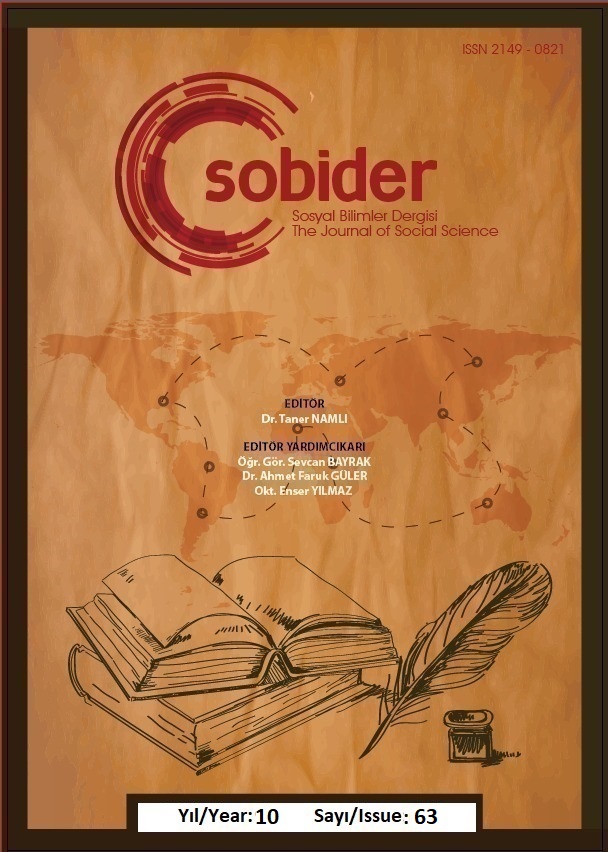AKDENİZ BÖLGESİNDEKİ TR61, TR62 VE TR63 DÜZEY-2 BÖLGELERİNDE 2007-2021 YILLARI ARASINDA NÜFUSUN GELİŞİMİ VE DEMOGRAFİK YAPININ DEĞİŞİMİ
Author :
Abstract
Akdeniz bölgesi (TR6) Türkiye’deki 12 düzey-1 bölgesinden biri olup bu bölgede TR61, TR62 ve TR63 düzey-2 bölgeleri bulunmaktadır. TR61 düzey-2 bölgesinde Antalya, Burdur ve Isparta, TR62 düzey-2 bölgesinde Adana ve Mersin, TR63 düzey-2 bölgesinde ise Hatay, Kahramanmaraş ve Osmaniye illeri (düzey-3 bölgeleri) bulunmaktadır. Bu çalışmanın amacı Akdeniz bölgesindeki düzey-2 bölgelerinde 2007-2021 yılları arasında nüfusun gelişimini ve demografik yapının değişimini incelemektir. Çalışmada TÜİK verilerinden yararlanılmış olup nicel yöntem kullanılmıştır. 2021 yılında Akdeniz bölgesinin nüfusun %38,1’i TR62, %31,2’si TR63 ve %30,7’si ise TR61 düzey-2 bölgesinde bulunmaktaydı. TR61, TR62 ve TR63 düzey-2 bölgelerinde 2007-2021 yılları arasında nüfus artmış olup artış hızı 14 yıllık süreçte TR61 bölgesinde %35 ile daha yüksekken TR63’te %19 ve TR62’de ise %15 olup daha düşük olmuştur. Bu durumun nedeni TR61 düzey-2 bölgesinde artı değerler alan net göç hızının diğer iki bölgede ise genellikle eksi değerler almış olmasıdır. 14 yıllık süreçte Akdeniz bölgesindeki düzey-2 bölgelerinde demografik yapı da değişmiştir. Her üç bölgede de çocuk nüfus oranı azalmış, yaşlı nüfus oranı ise artmıştır. Buna bağlı olarak TR61, TR62 ve TR63 bölgelerinde toplam bağımlılık oranı ve genç bağımlılık oranı azalmış, yaşlı bağımlılık oranı ise artmıştır. Günümüzde TR61 bölgesi daha düşük toplam doğurganlık hızı, çocuk nüfus oranı ve bağımlılık oranı, daha yüksek yaşlı nüfus oranı ile dikkat çekmektedir. TR63 bölgesi ise daha yüksek toplam doğurganlık hızı, çocuk nüfus oranı ve bağımlılık oranı ile daha düşük yaşlı nüfus oranı ile dikkat çekmektedir. TR62 bölgesinde ise toplam doğurganlık hızı, çocuk nüfus oranı ve bağımlılık oranı TR61 bölgesinden yüksek TR63 bölgesinden ise düşüktür.
Keywords
Abstract
The Mediterranean region (TR6) is one of the 12 level-1 regions in Turkey, which includes TR61, TR62 and TR63 level-2 regions. Antalya, Burdur and Isparta in TR61 level-2 region, Adana and Mersin in TR62 level-2 region, Hatay, Kahramanmaraş and Osmaniye provinces in TR63 level-2 region (level-3 regions). The aim of this study is to examine the population development and change demographic structure between 2007-2021 in the level-2 regions of the Mediterranean region. In the study, TUIK data was used and quantitative method was used. In 2021, 38.1% of the population of the Mediterranean region was in TR62, 31.2% in TR63 and 30.7% in TR61 level-2 region. In TR61, TR62 and TR63 level-2 regions, the population increased between 2007 and 2021, and the rate of increase was 35% higher in TR61 region, 19% in TR63 and 15% in TR62, in a 14-year period. The reason for this situation is that the net migration rate, which has positive values in the TR61 level-2 region, has generally negative values in the other two regions. In the 14-year period, the demographic structure has also changed in the level-2 regions of the Mediterranean region. In all three regions, the proportion of the child population decreased, while the proportion of the elderly population increased. Accordingly, the total dependency ratio and youth depe ndency ratio decreased, while the elderly dependency ratio increased in TR61, TR62 and TR63 regions. Today, the TR61 region draws attention with its lower total fertility rate, child population ratio and dependency ratio, and higher elderly population ratio. The TR63 region, on the other hand, draws attention with its higher total fertility rate, child population ratio and dependency ratio, and lower elderly population ratio. In the TR62 region, on the other hand, the total fertility rate, dependency ratio and the child population rate are higher than the TR61 region and lower than the TR63 region.





